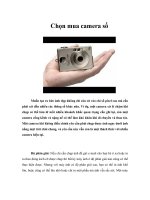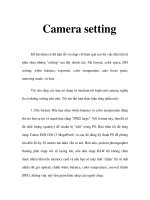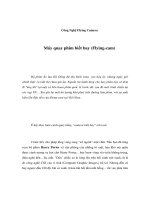Camera Basics Exposure
Bạn đang xem bản rút gọn của tài liệu. Xem và tải ngay bản đầy đủ của tài liệu tại đây (673.31 KB, 7 trang )
Camera Basics
Exposure
Exposure is one of the major factors that can make or break a picture. Let
us talk about how we can go about make best use of exposure to get the
best results from a shot.
“Exposure” refers to the brightness in a picture as decided by the interaction
between aperture and shutter speed
Points-to-note
- Cameras are equipped with an Auto exposure (AE) function.
- W e refer to brightness that is calculated and set by the camera as “correct
exposure”.
- If the correct exposure is not satisfactory, you can use exposure
compensation to adjust it.
The word “exposure” refers to the volume of light taken in at the instant the
picture is taken, which affects the brightness of the resulting image. This
volume of light is essentially de cided by the combination of the aperture and
shutter speed settings.
DSLR cameras are equipped with an automatic exposure (AE) function.
Therefore, under normal conditions where the ISO speed is constant, you
don’t have to think about which aperture and shutter speed setting will give
you the adequate exposure as it will be automatically set by the camera. We
can get good results with all sorts of scenes and subjects with this
automatically-set exposure, which we call the “correct exposure”.
However, correct exposure may not be the optimal exposure for the scene,
as depending on the condition of the scene and the subject, there are times
where the brightness of the scene does not turn out as we would like it to
be. When this happens, we can always make use of the exposure
compensation feature to adjust the brightness level. When we want the
image to look be darker, we can set a negative (“-“) exposure compensation
value. If we want a brighter image, we can set a positive (“+”) value.
Even when taking pictures of the same situation or the same subject, a
simple adjustment to the exposure can give you very different results. In
other words, the art of exposure compensation is something we must all
learn in taking a good picture.
When we turn the tap (aperture) on, the time taken for the water to
collect (shutter speed) is shorter
When tap (=aperture) is turned up, more water (=light) will flow in and the
time taken for the water to collect (=shutter speed) shortens (=becomes
faster) and is enough to get a good exposure. On the other hand, tap
(=aperture) is turned down, less water (=light) flows in, the time taken for
water to collect (=shutter speed) becomes longer.
Concept 1: Exposure results from interaction between aperture and shutter
speed
Using either of the following combinations would result in the same level of
brightness:
1. Larger aperture (smaller f -number) + faster shutter speed
2. Smaller aperture (larger f -number) + slower shutter speed
Look at examples (3), (5) and (7) below. They are the results of a different
combination of shutter speed and aperture. But you see the same brightness
(exposure) in the pictures.
Examples (3), (5) and (7) are all of the same brightness (correct exposure)
Example (1) is overexposed
Example (9) is underexposed
Concept 2: The auto exposure (AE) functions
Take a look at the chart below. It shows clearly how there are a few patterns
to the combination of aperture and shutter speed. You might find it difficult
to decide on which combination to pick. However, a digital camera is
equipped with some very convenient automatic exposure (AE) functions that
simplifies the process.
There is “Program AE mode” [ P ] mode )where the camera automatically
sets both aperture and shutter speed; “Shutter -priority AE” [ Tv ] mode,
where you set the shutter speed and the camera decides the aperture; and
“Aperture-priority AE” [ Av ] mode where you set the ape rture and the
camera decides the shutter speed. We will explain more about these modes
in future articles so do look out for them!
When you’ve set your camera to any of these modes, all you need to do is
release the shutter and you will get an image with t he appropriate exposure.
Convenient and hassle-free!









